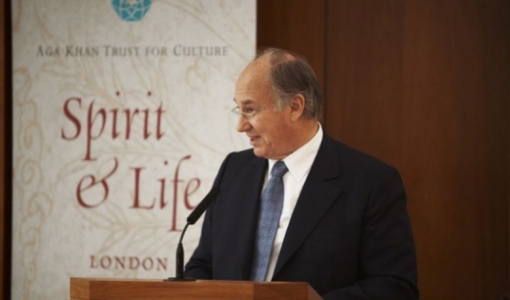FOREWORD BY HIS HIGHNESS THE AGA KHAN - SPIRIT & LIFE PUBLICATION -2007-01-01
Foreword by His Highness the Aga Khan
This exhibition of masterpieces from the Islamic world underlines that the arts, particularly when they are spiritually inspired, can become a medium of discourse that transcends the barriers of our day-today experiences and preoccupations. Many questions are currently being raised in the West about the Muslim world, with countless misconceptions and misunderstandings occurring between our contemporary societies. I thus hope that this exhibition will hold a special significance at a time which calls for enlightened encounters amongst faiths and cultures.
The hundred and seventy miniatures, manuscripts, ceramics and other art works on display offer no more than a fleeting glance of the breadth of the arts in Muslim cultures in their various forms. They are part of a larger collection that will be housed in a museum being specifically built to receive them in Toronto, Canada. The aim of the Aga Khan Museum will be to offer unique insights and new perspectives into Islamic civilizations and the cultural threads that weave through history binding us all together. My hope is that the Museum will also be a center of education and of learning, and that it will act as a catalyst for mutual understanding and tolerance.
The arts have always had a special significance for my family. More than a thousand years ago my ancestors, the Fatimid Imams, encouraged patronage of the arts and fostered the creation of collections of outstanding works of art and libraries of rare and significant manuscripts. Many of my family members are art lovers and collectors. In particular my late uncle, Prince Sadruddin Aga Khan, was a great connoisseur of manuscripts and miniatures, and many of the works on paper and parchment presented in this exhibition come from his collection. I have been adding to these holdings myself for a number of years to create a complementary collection of Islamic works of art. I believe that these works all contribute to an understanding of some of the aesthetic values which underpin Muslim arts and the humanistic traditions of Islam.
This exhibition illustrates how the Qur’an-e-Sharif, rich in parable and allegory, metaphor and symbol, is a fundamental source of inspiration, lending itself to a wide spectrum of interpretations. This freedom of interpretation is a generosity which the Qur’an confers upon all believers. It guides and illuminates the thought and conduct of Muslims belonging to different communities of spiritual affiliation, from century to century in diverse cultural environments. It extends its pluralistic outlook to adherents of other faiths too, affirming that each has a direction and a path, and should strive to perform good works.
A wide range of Muslim expressions in the arts, across time and space, are represented here. The Qur’an has inspired works in both art and architecture, and shaped attitudes and norms that have guided the development of Muslim artistic traditions. Scientific pursuits, philosophic inquiry and artistic endeavour alike are seen, within Islam, as a response to the Qur’an’s recurring call to ponder creation as a way to understand God’s benevolent majesty.
Faith challenges the artist, as much as the mystic, to go beyond the physical - the outward - to unveil that which lies at the center and gives life to the periphery. Masterpieces are like the ecstasy of the mystic: a gesture of the spirit, a stirring of the soul that attempts to capture that which is ineffable and beyond being.
This exhibition is to be shown in Parma and in London and, thereafter, hopefully in Portugal and Germany. The public at each of these venues will be very different, reflecting at times a more specifically European cultural background and at others more diverse cultural roots. The works of Muslim arts and culture this exhibition contains will, I hope, encourage dialogue with the arts and cultural achievements of each of the Exhibition’s host venues, this interaction leading to an appreciation of the shared legacies of our civilizations and an increasing respect between peoples and cultures.
The objects in this exhibition span over a thousand years of history. At times, the Muslim and Western worlds opposed each other in antagonism and conflict: at others, they cooperated constructively and in harmony. It was during the latter that the greatest scientific, social and economic developments occurred, to the benefit of all. It is my deepest wish that this be the path of the future.
- 7798 reads
 Ismaili.NET - Heritage F.I.E.L.D.
Ismaili.NET - Heritage F.I.E.L.D.